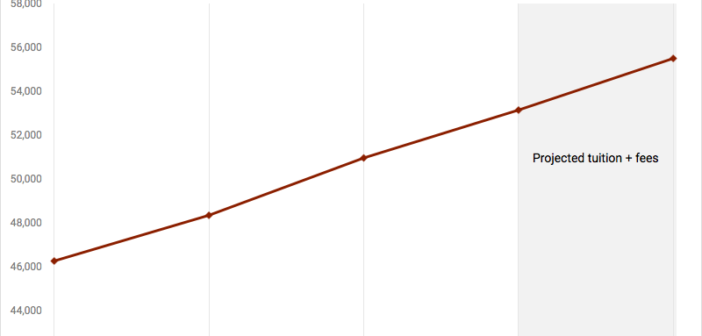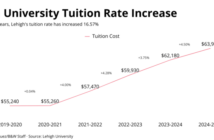More students means more revenue.
But as Lehigh students found out last week, it’s not that simple.
On Jan. 31, an email sent by the Office of Finance and Administration alerted Lehigh students and families that tuition for the 2019-2020 academic year will increase from $52,480 to $54,790. This 4.4 percent increase will mean the total cost, which includes room, board and other expenses, will be approximately $69,650.
Tuition increased by 4.3 percent from the 2017-18 academic year to 2018-19.
Patricia Johnson, the vice president of Finance and Administration, said the tuition raise was necessary to support the university’s academic mission.
She noted that tuition accounts for 57 percent of the university’s total revenue of about $538.4 million.
“When we do tuition increases, it’s because tuition supports (52 percent of the budget),” Johnson said. “What tuition supports is staff and faculty, all the operating expenses, financial aid, salaries, building maintenance and any other miscellaneous expenses.”
Johnson said with an aging population and an increase in students, the university hires 28-30 new faculty members each year — and each year, potential faculty members ask for more money, forcing the university to pay “market.”
Johnson said she believes the tuition increase was necessary to “continue to attract” students and faculty to the university. Salary and wages are the biggest chunk of this past year’s operating expenditures at approximately 35 percent.
Johnson said Lehigh can’t survive without the kinds of investments called for in the Path to Prominence plan, like the completed Building C renovation at Mountaintop.
“We look at all the expenses for the university, and we decide that piece of the tuition,” Johnson said. “We look at how many people we expect to hire, what the turnover rate is, medical expenses — because we give benefits to all our employees — and how much we need in financial aid. And that’s how we decide what the total budget will be, and then we have to decide what we need from tuition increases to pay for that.”
Both Johnson and Jennifer Mertz, the director of financial aid, said it’s important to keep the cost of Lehigh’s “peer institutions,” such as Wake Forest, Bucknell, Lafayette and Bowdoin, in perspective.
“I think what happened at Lehigh is there was a period where we had very low increases to tuition compared to our peer institutions,” Mertz said. “(I think what) we’re trying to make up for that. Our costs are still lower than our peer institutions, and I think that’s an important thing to note is compared to other institutions, where are we?”
Johnson agreed with Mertz that for several years, the university’s board of trustees was determined to keep tuition increases between 3 and 3.5 percent.
As for peer institutions, Lafayette College’s 2018-19 total bill stands at $69,270 — $475 greater than Lehigh’s cost of $68,795. Bucknell University’s tuition for this academic year is $69,754.
Though Mertz was not part of the decision to increase tuition, she said with the increase and the changing demographics of increased first-generation, lower-income students on campus, it is essential that the university continues to have financial aid as a funding priority.
She said $400 million of the GO Campaign’s $1 billion fundraising initiative will be dedicated to financial aid and that 50 percent of Lehigh’s students receive need-based aid.
“My concern, and hope, is that the university continues to see financial aid as a necessary cost of operating this university and continues to give to financial aid (for) what it needs to sustain,” Mertz said. “I think everybody can see the studies that… we will have more needy students and less full paying students moving forward… The demographics are shifting, and we have to be prepared for what it will cost us to have a class that looks like X, Y, Z — and how do we get the money to do that.”
Mertz said the university’s senior leaders are aware of the costs of the projects occurring across campus, as well as the future of financial aid at Lehigh, and said their plans are forward-thinking and not short-sighted.
Mertz received the email that was to go out to parents and families for proofreading at 9:30 a.m. on the day of release.
She said she corrected language to clear up that the university will provide an aided student with a similar need-based package as last year’s, but with an increase in financial aid by the percentage that reflects the tuition increase. She said that the original email said Lehigh meets “100 percent of need,” but that families often find that misleading and the new language therefore offers clarity.
However, Mertz’s changes never made it to the letter that was mailed to families in addition to the email — because the letter was already printed. Mertz said she was disappointed in the way that was handled.
Sara Boyd, ’21, the president and policy director of the Student Political Action Coalition, said the email that was sent out was “just not well thought out.”
“What Lehigh isn’t fully grasping is that this email is coming out in the wake of the #PathtoPoverty and the parking crisis that is bothering faculty across all jurisdictions,” Boyd said. “And they’ve never given a response to what truly happened two semesters ago when the roommate was accused of poisoning his roommate. A lot is happening at once, and then getting this email — it’s laughable to an extent. And then, of course, the Presidential Scholarship.”
Mertz didn’t shy away from the discontinuation of the Presidential Scholarship, either. She said she didn’t think that the program costs a whole lot, and that it was actually under-utilized.
But she also maintained that with all the building improvements and fundraising done, the university can still only spend 5 percent of its endowment funds every year. Johnson said the hope is that this endowment will grow to cover more expenses, so that more can be devoted to financial aid and ultimately the tuition won’t have to continue to increase at the rate it is.
Mertz acknowledged that with more students comes more staff, even if the overall revenue increases.
“The growth of more first generation, lower income students on campus means not only are counselors spending more time reviewing applications, but also spending more time with students,” Mertz said. “We’ve been a revolving door, and we want that to be the case…. But it also just puts some more stress on those who work here. I think that I’m optimistic that (our staffing needs) will be met in the future…. I have seen data presented to the board from the Office of Institutional Research that showed that (admissions and financial aid) are two departments who should have another person.”
Both Johnson and Mertz said the reaction from students and families has been moderate, but that they are both doing the best they can to answer all inquiries and explain the situation and what it means for their family.
Mertz said she expects complaints to pick up once full financial aid notifications are issued.
Johnson defended the tuition increase, framing it as a worthwhile investment that shows when Lehigh students look to get jobs upon graduating.
“It is necessary for us to maintain our competitiveness (and) our rankings, which have gone down and need to go back up, to support the academic mission,” Johnson said. “We will continue to try to get the best that we can get to keep the product, the class offerings, very competitive and very sensitive to what people are wanting to do.”






Comment policy
Comments posted to The Brown and White website are reviewed by a moderator before being approved. Incendiary speech or harassing language, including comments targeted at individuals, may be deemed unacceptable and not published. Spam and other soliciting will also be declined.
The Brown and White also reserves the right to not publish entirely anonymous comments.
3 Comments
When I graduated in 1988, tuition, room and board, and fees amounted to approximately $16,550 per year. According to the Fed, the average inflation rate since that date has resulted in a little over a doubling of prices since that date. Applied to the Lehigh tuition, that would have resulted in an attendance cost of approximately $33,800. The increases while I attended school (around 8% per year) were obscene, and the rate of increase in cost of attendance since I graduated is more than double the average inflation rate. Now I understand that the CPI is a basket of market items and that some items rise faster than others, but this continued outpacing of inflation is ridiculous. The idea that the tuition increases are necessary to remain competitive with its peers is laughable. I believe a de-emphasizing of the engineering programs (once ranked among the top twenty or so in the nation) and graduates saddled with unreasonable debt (and therefore less likely to donate) have been the drivers in the ranking declines. Rankings are in part based on selectivity of the school, and if Lehigh were to reduce its costs relative to its peers it might find itself in a position where it is a more desirable destination than those same peers, leaving it in able to become much more selective. The University also might find that its still successful graduates might be more generous from day one if they don’t leave with stressful memories of the annual struggles to pay the bills and the need to devote such large portions of their paychecks to repaying loans taken out to finance the quality education they received. My daughter would like to follow in her father’s footsteps to Bethlehem, and I would love for her to be able to, but given the nearly $70,000 a year price tag, I find it hard to say this is the best investment option.
Not to mention that the school was much better regarded when we were students than it is now….
How about you try finding a solution that reduces expenses? And what is the definition of low income? At 70k a year anyone outside of the top 5% of income brackets can afford that without strapping their kid with debt or forgoing their own retirement. Instead worrying about what Bucknell and Lafayette are doing why doesn’t Lehigh be a leader in this category? The bubble is going to burst soon enough so you better get ahead of the curve.